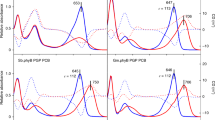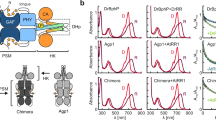Abstract
Aspergillus nidulans senses red and blue-light and employs a phytochrome and a Neurospora crassa White Collar (WC) homologous system for light perception and transmits this information into developmental decisions. Under light conditions it undergoes asexual development and in the dark it develops sexually. The phytochrome FphA consists of a light sensory domain and a signal output domain, consisting of a histidine kinase and a response regulator domain. Previously it was shown that the phytochrome FphA directly interacts with the WC-2 homologue, LreB and another regulator, VeA. In this paper we mapped the interaction of FphA with LreB to the histidine kinase and the response regulator domain at the C-terminus in vivo using the bimolecular fluorescence complementation assay and in vitro by co-immunoprecipitation. In comparison, VeA interacted with FphA only at the histidine kinase domain. We present evidence that VeA occurs as a phosphorylated and a non-phosphorylated form in the cell. The phosphorylation status of the protein was independent of the light receptors FphA, LreB and the WC-1 homologue LreA.




Similar content being viewed by others
References
Bae G, Choi G (2008) Decoding of light signals by plant phytochromes and their interacting proteins. Annu Rev Plant Biol 59:281–311
Bayram Ö, Krappmann S, Seiler S, Vogt N, Braus GH (2007) Neurospora crassa ve-1 affects asexual conidiation. Fungal Genet Biol 45:127–138
Bayram Ö, Biesemann C, Krappmann S, Galland P, Braus GH (2008a) More than a repair enzyme: Aspergillus nidulans photolyse-like CryA is a regulator of sexual development. Mol Biol Cell 19:3254–3262
Bayram O, Krappmann S, Ni M, Bok JW, Helmstaedt K, Valerius O, Braus-Stromeyer S, Kwon NJ, Keller NP, Yu JH, Braus GH (2008b) VelB/VeA/LaeA complex coordinates light signal with fungal development and secondary metabolism. Science 320:1504–1506
Bhoo S-H, Davis SJ, Walker J, Karniol B, Vierstra RD (2001) Bacteriophytochromes are photochromic histidine kinases using a biliverdin chromophore. Nature 414:776–779
Blumenstein A, Vienken K, Tasler R, Purschwitz J, Veith D, Frankenberg-Dinkel N, Fischer R (2005) The Aspergillus nidulans phytochrome FphA represses sexual development in red light. Curr Biol 15:1833–1838
Busch S, Braus GH (2007) How to build a fungal fruit body: from uniform cells to specialized tissue. Mol Microbiol 64:873–876
Calvo AM (2008) The VeA regulatory system and its role in morphological and chemical development in fungi. Fungal Genet Biol 45:1053–1061
Calvo AM, Wilson RA, Bok JW, Keller NP (2002) Relationship between secondary metabolism and fungal development. Microbiol Mol Biol Rev 66:447–459
Fischer R (2008) Sex and poison in the dark. Science 320:1430–1431
Fischer R, Kües U (2006) Asexual sporulation in mycelial fungi. In: Kües U, Fischer R (eds) The Mycota, growth differentiation and sexuality, vol I. Heidelberg, Springer, pp 263–292
Froehlich AC, Noh B, Vierstra RD, Loros J, Dunlap JC (2005) Genetic and molecular analysis of phytochromes from the filamentous fungus Neurospora crassa. Eukaryot Cell 4:2140–2152
Hiltbrunner A, Tscheuschler A, Viczián A, Kunkel T, Kircher S, Schäfer E (2006) FHY1 and FHL act together to mediate nuclear accumulation of the phytochrome A photoreceptor. Plant Cell Physiol 47:1023–1034
Käfer E (1977) Meiotic and mitotic recombination in Aspergillus and its chromosomal aberrations. Adv Genet 19:33–131
Kato N, Brooks W, Calvo AM (2003) The expression of sterigmatocystin and penicillin genes in Aspergillus nidulans is controlled by veA, a gene required for sexual development. Eukaryot Cell 2:1178–1186
Kim H-S, Han K-Y, Kim K-J, Han D-M, Jahng K-Y, Chae K-S (2002) The veA gene activates sexual development in Aspergillus nidulans. Fungal Genet Biol 37:72–80
Lamparter T, Mittmann F, Gärtner W, Borner T, Hartmann E, Hughes J (1997) Characterization of recombinant phytochrome from the Cyanobacterium synechocystis. Proc Natl Acad Sci USA 94:11792–11797
Li S, Myung K, Guse D, Donkin B, Proctor RH, Grayburn WS, Calvo AM (2006) FvVE1 regulates filamentous growth, the ratio of microconidia to macroconidia and cell wall formation in Fusarium verticillioides. Mol Microbiol 62:1418–1432
Linden H, Macino G (1997) White Collar 2, a partner in blue-light signal transduction, controlling expression of light-regulated genes in Neurospora crassa. EMBO J 16:98–109
Mooney JL, Yager LN (1990) Light is required for conidiation in Aspergillus nidulans. Genes Dev 4:1473–1482
Ni M, Tepperman JM, Quail MA (1998) PIF3, a phytochrome-interacting factor necessary for normal photoinduced signal transduction, is a novel basic helix-loop-helix protein. Cell 95:657–667
Ni M, Tepperman JM, Quail PH (1999) Binding of phytochrome B to its nuclear signalling partner PIF3 is reversibly induced by light. Nature 400:781–784
Pontecorvo G, Roper JA, Hemmons LM, MacDonald KD, Bufton AWJ (1953) The genetics of Aspergillus nidulans. Adv Genet 5:141–238
Purschwitz J, Müller S, Kastner C, Fischer R (2006) Seeing the rainbow: light sensing in fungi. Curr Opin Microbiol 9:566–571
Purschwitz J, Müller S, Kastner C, Schöser M, Haas H, Espeso EA, Atoui A, Calvo AM, Fischer R (2008) Functional and physical interaction of blue and red-light sensors in Aspergillus nidulans. Curr Biol 18:255–259
Rockwell NC, Lagarias JC (2006) The structure of phytochrome: a picture is worth a thousand spectra. Plant Cell 18:4–14
Sambrook J, Russel DW (1999) Molecular cloning: a laboratory manual. Cold Spring Harbor Laboratory Press, Cold Spring Harbor
Stinnett SM, Espeso EA, Cobeno L, Araujo-Bazan L, Calvo AM (2007) Aspergillus nidulans VeA subcellular localization is dependent on the importin alpha carrier and on light. Mol Microbiol 63:242–255
Sweere U, Eichenberg K, Lohrmann J, Mira-Rodado V, Bauerle I et al (2001) Interaction of the response regulator ARR4 with phytochrome B in modulating red light signaling. Science 294:1108–1111
van der Horst MA, Key J, Hellingwerf KJ (2007) Photosensing in chemotrophic, non-phototrophic bacteria: let there be light sensing too. T Microbiol 15:554–562
Veith D, Scherr N, Efimov VP, Fischer R (2005) Role of the spindle-pole body protein ApsB and the cortex protein ApsA in microtubule organization and nuclear migration in Aspergillus nidulans. J Cell Sci 118:3705–3716
Waring RB, May GS, Morris NR (1989) Characterization of an inducible expression system in Aspergillus nidulans using alcA and tubulin coding genes. Gene 79:119–130
Yager LN, Lee HO, Nagle DL, Zimmermann JE (1998) Analysis of fluG mutations that affect light-dependent conidiation in Aspergillus nidulans. Genetics 149:1777–1786
Yelton MM, Hamer JE, Timberlake WE (1984) Transformation of Aspergillus nidulans by using a trpC plasmid. Proc Natl Acad Sci USA 81:1470–1474
Acknowledgments
This work was supported by the Max-Planck-Institute for terrestrial Microbiology (Marburg), the special program “Lebensmittel und Gesundheit” from the Landesstiftung Baden-Württemberg and the Center for Functional Nanostructures.
Author information
Authors and Affiliations
Corresponding author
Additional information
Communicated by J. Perez-Martin.
Rights and permissions
About this article
Cite this article
Purschwitz, J., Müller, S. & Fischer, R. Mapping the interaction sites of Aspergillus nidulans phytochrome FphA with the global regulator VeA and the White Collar protein LreB. Mol Genet Genomics 281, 35–42 (2009). https://doi.org/10.1007/s00438-008-0390-x
Received:
Accepted:
Published:
Issue Date:
DOI: https://doi.org/10.1007/s00438-008-0390-x




